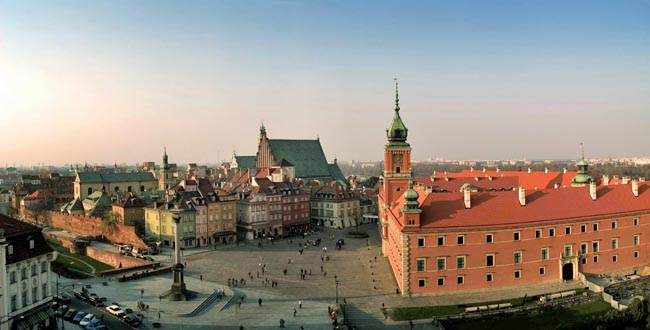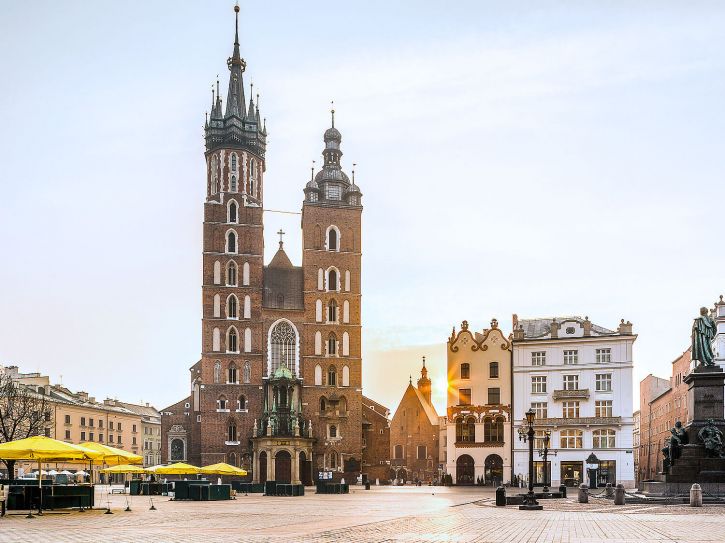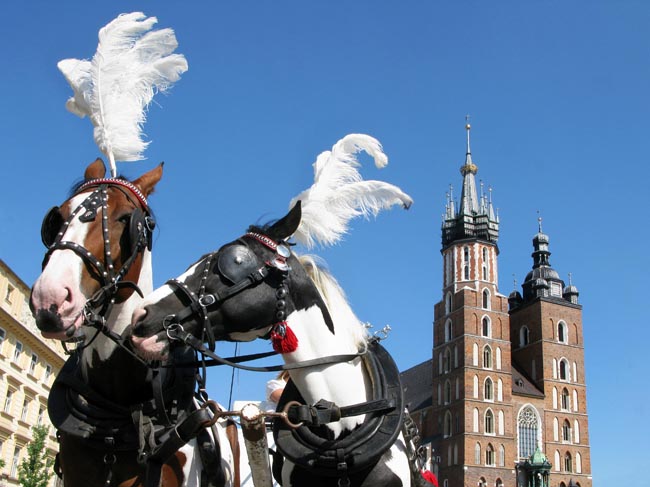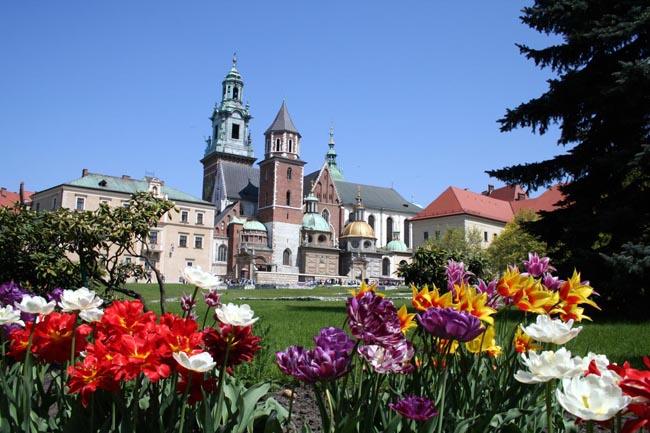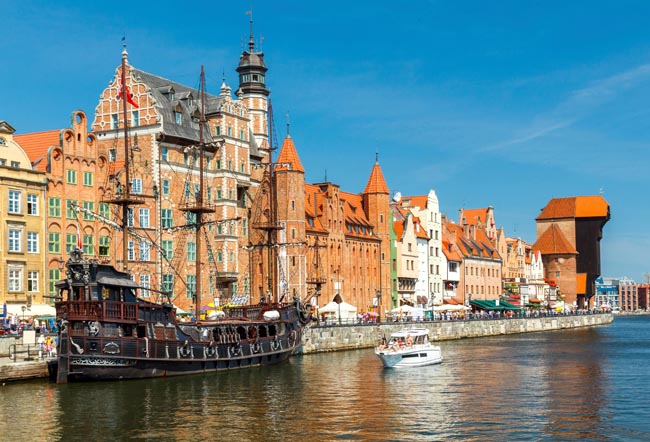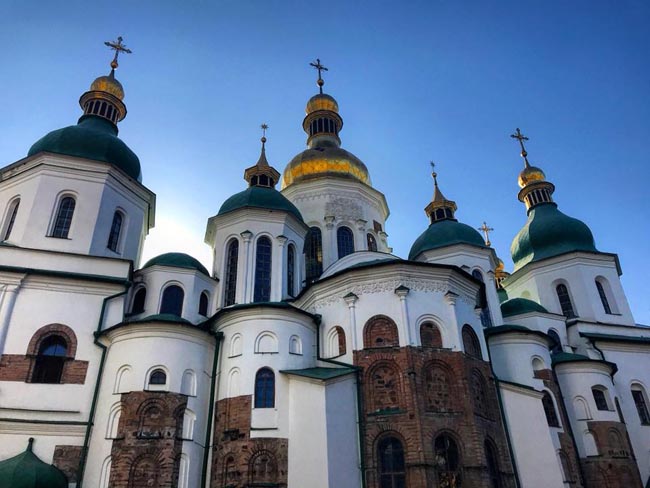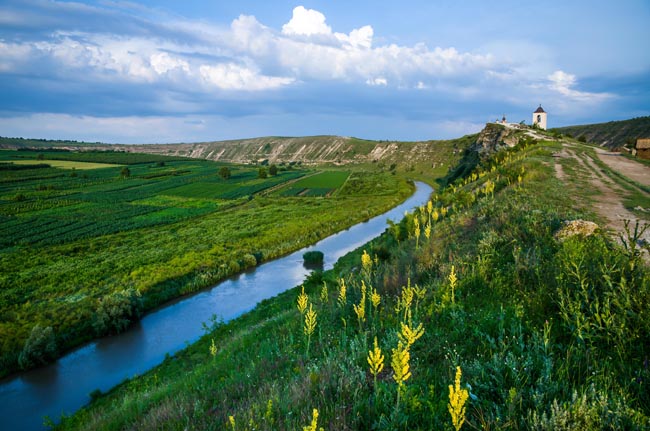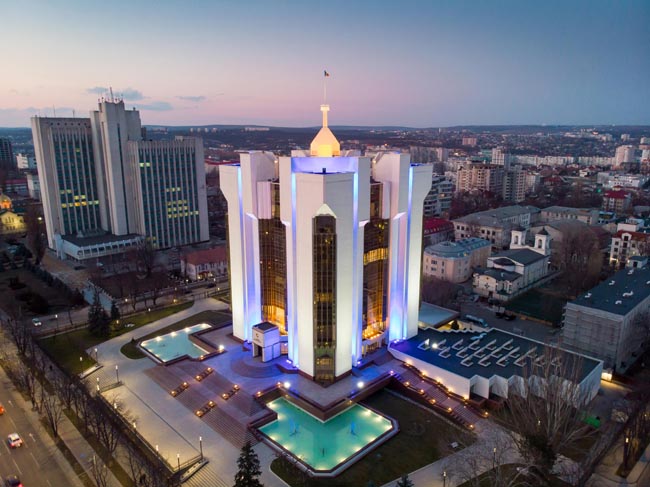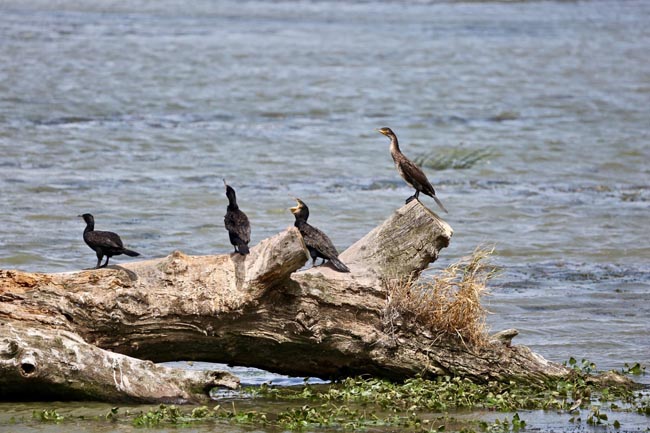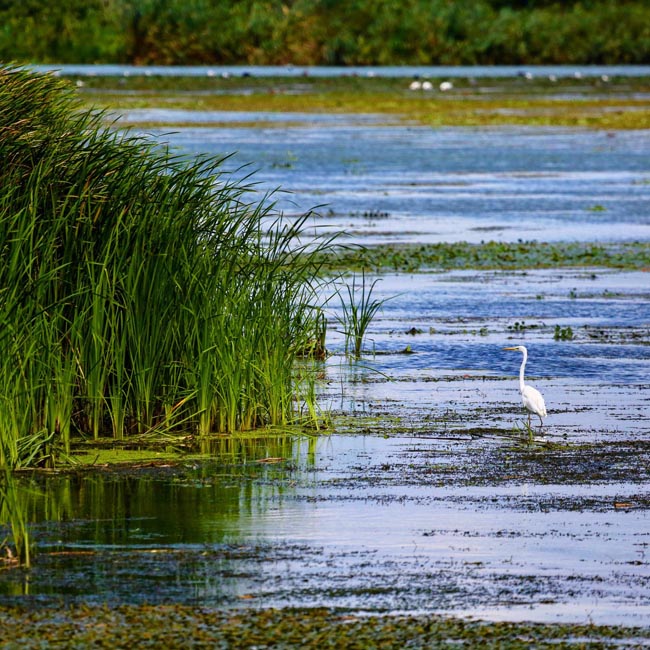Displaying a fascinating mixture of Slavic eastern and German western influences Poland's capital city, Warsaw, immerses travellers in a unique world of mystifying contrasts and sets an apt tone for our 23-day adventure exploring the hidden gems of these three Eastern European lands of plenty. Meandering through cobblestone streets, we visit the churches, palaces and marketplace in the Old Town, much of which has undergone considerable restoration efforts since the Second World War, and we marvel at the broad range of architectural style. We stop in at no fewer than a dozen cities and towns as we continue through scenic countryside, enjoying world-famous attractions in the larger urban areas like Gdansk and heading into rural Poland for a taste of the day-to-day life of its friendly inhabitants. Flying into Belarus, we find a land whose plethora of historic monuments are dedicated to the casualties and victims of the Great Patriotic War, or Second World War as the West knows it. From war memorials, to graveyard villages and from the Trees of Life, which commemorate the 433 villages destroyed by the Nazis, to the Memory Wall, which lists the Nazi concentration camps and their victims, Belarus is a nation whose very identity is rooted deep in the events of its tragic past. From here, it's on to Ukraine, a land that boasts world-famous UNESCO Heritage Sites, fascinating underground catacombs and innumerable historical sites of interest, such as the setting of the famous 'Charge of the Light Brigade' during the Crimean War. We wander along palatial-fringed avenues, stop off in a number of museums brimming with ancient artifacts and learn first-hand about life in Ukraine by mingling with the welcoming locals along the way.
Prices below are per person, twin-sharing costs in US Dollars (USD). Pricing does not include airfare to/from the tour and any applicable taxes. For single supplement rates and taxes (if any), please refer to below Prices & Dates table. For general information on flights to/from the tour, click here.
Your Travel and Accommodation Arranged For You
Tips Included for Driver, Restaurant Staff, Local Guides
Authentic Local Experiences With Lots Of Inclusions.
Select a date below to reserve your spot:
The above prices are subject to an additional $110 for taxes/fees levied on flights that occur as part of the tour. The internal airfares ARE included (any exceptions are listed in red below), but we list the taxes separately on your invoice as they are beyond our control and can change at any time.
Optional Single Supplement: $1340 USD (number of singles limited).
Download Itinerary
Day 1 Arrive in Krakow
Arrival in Krakow.
Krakow is one of the most beautiful cities in Europe. It was originally the home of the Polish royalty (between 1038 and 1596), before the capital was moved to Warsaw. The cobblestone streets, majestic churches (almost 100!), and old world charm make Krakow an unforgettable destination.
Overnight in Krakow.
Included Meal(s): Dinner
Day 2 Krakow: City Walking Tour
Krakow is very compact, and the whole central region with its cobblestone streets is full of well-preserved architecture, Gothic churches and splendid museums. On our sightseeing tour (largely on foot at a leisurely pace) we visit Wawel Hill with the Royal Castle, Market Square, and the 16th century Renaissance Cloth Hall. We continue onward to Jagiellonian University and St Mary's Church with the Wit Stwosz altar. This was designed in 1489 by Wit Stwosz of Nuremburg and is the finest sculptural work in Poland.
We then stroll down the hill from the castle complex and enter the Old Town, one of the most famous old districts in Poland and the centre of Poland's political life from 1038 until King Sigismund III Vasa relocated his court to Warsaw in 1596. The entire medieval old town is among the first sites chosen for the UNESCO's World Heritage List. The district features the centrally located Rynek Glowny, or Main Square, the largest medieval town square of any European city. There is a number of historic landmarks in its vicinity, such as St. Mary's Basilica (Kosciol Mariacki), Church of St. Wojciech (St. Adalbert's), Church of St. Barbara, as well as other national treasures.
While in Krakow, we'll also have a walking visit of Kazimierz, once an independent town governed separately from Krakow until the late middle ages. Later, it became known as the Jewish Quarter of the city and was finally transformed into a center for Krakow’s beatnik bars and cafe culture.
Overnight in Krakow.
Included Meal(s): Breakfast and Dinner
Not finding what you're looking for?
Our specialists can take away the stress and create a private custom tour tailored to your exact interests and budget.
Day 3 Oskar Schindler Museum & Wieliczka Salt Mines
This morning we visit the Oskar Schindler's Factory Museum. The story of Oskar Schindler and his employees is one which has been well-known since the book and film by Thomas Keneally and Steven Spielberg (whose film 'Schindler's List' was shot almost entirely in Krakow). Individual histories of Krakow's wartime inhabitants guide visitors through the exhibit which covers the war of 1939, everyday life under occupation, the fate of the Jews and the city's underground resistance using vast archival documents, photos, radio and film recordings, period artifacts and multimedia.
After a break for lunch featuring Polish specialties,* we'll embark on a truly unique adventure: a descent into the Wieliczka Salt Mines. This isn't your average mine tour. Prepare to be amazed as we journey 5 kilometers (3 miles) beneath the earth's surface, exploring a world sculpted entirely by salt.
We'll wander through a labyrinth of salt-formed caves and grottoes, each with its own unique character and charm. Our descent will lead us to a mesmerizing subterranean lake, its surface reflecting the eerie glow of the mine lamps. And, perhaps the most awe-inspiring sight of all, we'll visit a chapel adorned with intricate sculptures, all carved entirely from the surrounding salt.
The scale of this operation is truly staggering. The Wieliczka Salt Mines boast 11 levels of galleries, stretching an incredible 300 kilometers (186 miles) in total. Over 700 years of continuous mining have yielded a staggering 20,000,000 tonnes (22,000,000 tons) of rock salt.
But the history of the Wieliczka Salt Mines goes beyond mere extraction. Local legend tells the tale of Princess Kinga, a Hungarian princess whose lost ring was miraculously found within a block of salt mined here in the 13th century. This discovery is said to be the origin story of the mines themselves.
Return to Krakow.
* Because of the fullness of our day, and because past travellers indicated a desire for some independence for dinner while in Krakow (and an earlier night), we include a light lunch instead of dinner today.
Overnight in Krakow.
Included Meal(s): Breakfast and Lunch
Day 4 Krakow - Oswiecim (Auschwitz) - Czestochowa - Lodz
Today we embark on a poignant journey to Oswiecim (Auschwitz) and Brzezinka (Birkenau), the former Nazi concentration camps that now serve as a haunting memorial to the 1.5 million victims of 28 nationalities who perished here. As we walk through the camp's somber grounds, our knowledgeable guide will reveal the compelling history of this site, sharing personal stories and anecdotes that bring the past to life. This emotional experience will leave a lasting impression, reminding us of the importance of tolerance, compassion, and humanity.
We continue our journey to Czestochowa, the spiritual heart of Poland, where pilgrims from far and wide flock to Jasna Gora (Luminous Mountain) Monastery. This revered site is home to the iconic Black Madonna, Poland's most cherished relic, said to have been painted by St. Luke the Evangelist himself. Legend has it that the icon was brought from Jerusalem and installed in the monastery in 1384. As we explore the monastery, we'll delve into the fascinating history and symbolism surrounding this sacred image.
Our final destination today is Lodz (pronounced "Wooj"), a city with a rich and diverse heritage. Once a small settlement, Lodz blossomed into one of Europe's largest textile industry centers in the 19th century, earning the nickname "a promised land" and "a city of many cultures." As we arrive in Lodz, we'll discover a city that proudly celebrates its multicultural roots, where people of different nationalities and faiths came together to build a thriving community. We'll have time to explore the city's unique character and enjoy dinner at one of its many restaurants.
Overnight in Lodz.
Included Meal(s): Breakfast and Dinner
Day 5 Lodz - Warsaw: City Tour
This morning, we journey to Warsaw, Poland's resilient capital, where a rich history and vibrant culture await. Upon arrival, we embark on a comprehensive city tour, exploring the meticulously restored Old Town, a testament to the city's determination and spirit. After being razed during World War II, Warsaw's citizens embarked on a remarkable reconstruction campaign, resulting in today's stunning UNESCO-protected site. As we wander through the cobblestone streets, we'll discover an impressive array of churches, palaces, and marketplaces, showcasing the city's fascinating history, spanning from the 13th to the 20th century.
Having shaken off its Soviet-era persona, Warsaw has emerged as a thriving business and cultural hub, proudly showcasing its true colours. Our sightseeing adventure begins with a scenic drive along the Royal Route, followed by a brief orientation tour of the city. We'll delve into the historic Old Town on foot, visiting iconic landmarks such as Castle Square and the Uprising Monument. Next, we'll cross the river to the Praga district, where we'll take in the panoramic views of the city. Our journey continues in the Jewish Ghetto area, where we'll visit the poignant Umschlag Platz and the Museum of the History of Polish Jews. This state-of-the-art museum tells the captivating story of Poland's Jewish community, which flourished for over a thousand years, through a multimedia narrative exhibition.
Overnight in Warsaw.
Included Meal(s): Breakfast and Dinner
Day 6 Warsaw Sightseeing - To Torun
As we bid farewell to Warsaw, we pay a poignant visit to the Warsaw Uprising Museum, a poignant tribute to the brave men and women who fought for Poland's freedom during World War II. Located in a former tram power station, the museum is a treasure trove of artifacts, personal stories, and historical records that bring the 1944 Warsaw Uprising to life. Explore the exhibits, which include weapons, love letters, and personal belongings of the insurgents, and gain a deeper understanding of this pivotal moment in Polish history.
Having delved into Warsaw's complex past, we journey to the enchanting medieval town of Torun, nestled on the banks of the Vistula River in northwestern Poland. This charming city, a UNESCO World Heritage Site, boasts an astonishingly well-preserved medieval architecture, having miraculously escaped bombing during World War II. Stroll through the cobblestone streets and admire the stunning Gothic buildings, including the majestic St. Mary's Church. As we wander, the warm atmosphere of the old town envelops us, inviting us to linger at one of the many outdoor cafes and restaurants, where we can indulge in local delicacies and soak up the timeless charm of Torun.
Overnight in Torun.
Included Meal(s): Breakfast and Dinner
Day 7 Torun: Nicolaus Copernicus Museum - Gdansk
This morning, we delve into the charms of Torun, a medieval gem nestled on the Vistula River. As we wander through the UNESCO-listed Old Town, we're surrounded by the city's rich history and architectural splendor. Admire the imposing 13th-century Town Hall, one of the most impressive in Northern Europe, and explore the stunning churches and historic streets that preserve Torun's past glory.
Our journey continues at the Nicolaus Copernicus Museum, located in the very house where the renowned astronomer was born. Step into the world of Copernicus and discover an incredible collection of artifacts, including rare books, ancient prints, and intricate models of astronomical instruments. Gain insight into the life and work of this Polish genius, who revolutionized our understanding of the universe.
As we make our way to Gdansk, the 'Maritime Pearl of Poland,' we're enchanted by the city's captivating blend of medieval charm and maritime heritage. The city's skyline is dominated by towering, narrow buildings with peaked roofs and decorative facades, perfectly complemented by the cobblestone streets. The famous Gdansk Shipyards, where the Solidarity movement was born, are visible from many parts of the city.
As we explore Gdansk's marvellous Old Town, we stroll along the iconic Dlugi Targ (Long Market), lined with picturesque buildings, quaint shops, and lively cafes. Every step reveals a new treasure, from the majestic Neptune's Fountain to the impressive St. Mary's Church, one of the largest brick churches in the world.
Overnight in Gdansk.
Included Meal(s): Breakfast and Dinner
Day 8 Gdansk Area Tour
Its position on the Baltic has historically made Gdansk one of the most important port cities in Northern Europe, and tragically also the scene of a rather disturbing past. World War II was ignited by a dispute over the control of the city. By the end of the war the city lay almost completely in ruins. The German population was expelled and replaced by Poles as the city came under Polish rule and changed its name to Gdansk. However, the impact of its former German ties is still evident. Although most of the old buildings were damaged or destroyed in WWII, they have been painstakingly restored or rebuilt.
This morning we head out of town a short distance to visit the Oliwa Cathedral. This Holy Trinity, Blessed Virgin Mary, and St Bernard's Church was first erected as a Cistercian shrine back in the 13th century. Reconstructed in 1350 after a great fire, it re-emerged in the Gothic style, but many of the new fixtures were to be relatively short lived. The Gothic interior was extremely damaged in a 1577 fire and was replaced with the Baroque fixtures we admire today for their beauty and intensity.
The Oliwa Cathedral is perhaps best known for its massive, splendid organ. The organ is comprised of over 7,000 pipes and is decorated with movable angels and brightly painted stars. When built, the instrument was the largest in Europe. The main alter is also very impressive, and if the organ is in use, you're sure to be riveted by its magnificent sound!
While in Gdansk we'll also visit the European Solidarity Centre, a museum and library devoted to the history of Solidarity, the Polish trade union and civil resistance movement, and other opposition movements of Communist Eastern Europe.
The balance of the day is free to enjoy Gdansk. Gdansk is sometimes called the Amber Capital of the World; the surrounding area is the richest known source of this semi-precious stone, and the product can be viewed (and purchased, of course) in many shops in town. In order to maximize your free time in this interesting place, we do not include dinner this evening.
Overnight in Gdansk.
Included Meal(s): Breakfast
Day 9 Gdansk - Malbork - Olsztyn
This morning, we embark on a scenic drive to Olsztyn, nestled in the heart of Poland's breathtaking lake district. En route, we make a thrilling stop at the majestic Teutonic Knights Castle in Malbork, a UNESCO World Heritage Site and the largest brick building in Europe. This imposing 13th-century fortress, with its towering walls, grand halls, and intricate Gothic architecture, is a testament to the region's rich history and a must-see attraction.
As we continue our journey, the landscape unfolds like a canvas of rolling hills, sparkling lakes, and dense forests. We arrive in Olsztyn, a charming town surrounded by the pristine beauty of the Masurian Lake District. The crowning jewel of Olsztyn is its picturesque old town, encircled by a set of well-preserved fortified walls that whisper tales of the past. As we wander through the narrow streets, we'll discover a treasure trove of medieval architecture, quaint shops, and cozy cafes, inviting us to soak up the town's warm atmosphere.
Overnight in Olsztyn.
Included Meal(s): Breakfast and Dinner
Day 10 Olsztyn - Olsztynek - Warsaw
This morning, we bid farewell to Olsztyn and embark on a scenic drive back to Warsaw. En route, we make a fascinating stop at the Ethnographic Park in Olsztynek, home to the Museum of Folk Architecture, one of Europe's oldest and most captivating open-air museums.
As we wander through the park's picturesque grounds, we'll discover a treasure trove of traditional folk architecture, showcasing the region's rich cultural heritage. Admire the charming wooden houses, rustic barns, and historic windmills, each one telling a story of the past. Step inside the beautifully restored old homes, and explore the evangelical church, blacksmith, pottery stand, and windmill, each one offering a glimpse into the region's traditional way of life.
Be sure to check out the temporary exhibitions, featuring an array of traditional handicrafts and modern folk art from the region. From intricate woodcarvings to vibrant textiles, these exhibits showcase the region's enduring passion for traditional craftsmanship. After a captivating morning at the Ethnographic Park, we continue our journey back to Warsaw, filled with unforgettable memories of Poland's rich cultural heritage.
Overnight in Warsaw.
Included Meal(s): Breakfast and Dinner
Day 11 Warsaw, Poland - Kyiv, Ukraine
Today we fly from Warsaw to Kyiv ("Kiev" in Russian), capital of Ukraine.
Overnight in Kyiv.
Included Meal(s): Breakfast and Dinner
Day 12 Kyiv: City Tour
Today we a full day of sightseeing in Kyiv, the capital city of Ukraine. Our day will start at the cathedral of Hagia Sophia, the oldest cathedral in Ukraine. Founded in the early 11th century, and largely rebuilt during the 17th and 18th centuries, it is now a museum with beautiful Christian frescoes. St Sophia Cathedral is inscribed on the UNESCO World Heritage List.
During our tour we will see the Golden Gate, the historic gateway in the ancient city walls of Kyiv. We will visit St Andrew's Church, designed by Rastrelli, the famous architect who built the world famous Winter Palace in St. Petersburg. Just nearby is Andrew's Ascent, (Andriyivky Uzviz), Kyiv's most popular street with tourists and locals alike. Named after the nearby Baroque St. Andrew’s Church, this street was once the connecting avenue between the aristocratic strongholds called the Upper City and the mercantile center of dockside Podil.
We will tour St Michael's Monastery; a precious Kyivan relic, sky-blue in colour, with its golden glitter of cupolas and vividly decorated arches. The Archangel Michael is considered to be the patron of Kyiv. A highlight for many will be our visit to the Kyiv-Pechersk Lavra, also known as the 'Kyiv Monastery of Caves'. Here we will be able to see the famous caves, one of the most sacred places of Orthodox Christianity. Within this complex we also visit the unique museums of precious historical items, and collections of ancient books and icons.
During our touring of this city we will be sure to stop nearby Kreshatyk, the 'main street' of Kyiv. We will walk along this street to Independence Square. Kreshatyk teems with people as it gently curves through the nation's capital. This street has a regal feel and leads directly to the main and most beautiful square in the city -- Independence Square.
Overnight in Kyiv.
Included Meal(s): Breakfast and Dinner
Day 13 Kyiv - Lviv
This morning we head to the suburbs of Kyiv to the sobering memorial at Babi Yar. Kyiv had a Jewish population of 175,000 on the eve of the Nazi invasion of the Soviet Union in 1941. The Nazi forces captured the city in mid-September; within less than a fortnight, on the 29th and 30th, nearly 34,000 Jews of the ghetto were brought to a suburban ravine known as Babi Yar, near the Jewish Cemetery, where men, women, and children were executed over two days. In subsequent months, most of the remaining population was exterminated.
Today we will also visit the Chernobyl Museum in Kyiv. This museum houses models and memorabilia designed to educate the public about the many aspects of the Chernobyl disaster.
Later today we will fly from Kyiv to Lviv, the "capital" of Western Ukraine and one of the country's most impressive cities. Lviv, a UNESCO World Heritage Site, has a rich and impressive history. Numerous historical events are concerned with the city. The walls of old Lviv buildings still keep the spirit of past centuries; cozy streets and fascinating monuments make it a unique attraction among the Ukrainian and Eastern European cities. The Ukrainian Catholic Church, forced underground by Stalin in 1946, re-emerged here with Glasnost in the late 1980s to play a significant role in a new Ukrainian independence movement.
Overnight in Lviv.
Included Meal(s): Breakfast and Dinner
Day 14 Lviv: City Tour
Lviv's architectural landscape joins the monuments of numerous styles and different epochs. From the gothic 14th Century Latin Cathedral, to the baroque of St. George (Sviatoho Yura) Cathedral. Renaissance-style Bernardine Monastery and Chapel of Boimes co-exist with the strict simplicity of Armenian Church.
Today we will enjoy a city tour (mostly on foot) of the major highlights of Lviv. We will start by driving to the High Castle Hill, once the location of the main defensive fort of the city. A visit here provides us with a great panorama view over the surrounding region. Down in the city center we will visit the 13th Century St. Nicholas Church, one of the oldest functioning Orthodox churches in Lviv. Nearby the Church of the Assumption (which we also visit) is one of Lviv's most conspicuous landmarks, the Korniakt Tower from the 16th Century.
Along our walk we will stop to step inside the Pharmacy Museum of Lviv, dating back to 1735. The Market Square in Lviv is the central square of the city, with history dating back to the 14th Century. The town hall stands in the middle and is surrounded by about 44 burgher houses of various architectural styles, each with its own history.
We will also stop at the 17th Century Church of St. Parasceve and St. Georges Cathedral. Our walk through the historical center will end along Svobody Prospekt (Freedom Avenue), Lviv's main boulevard in the city. The most impressive building here is the magnificent Opera House, built in 1897-1900.
Overnight in Lviv.
Included Meal(s): Breakfast and Dinner
Day 15 Lviv: Lychakivsky Cemetery & Museum of Folk Architecture and Rural Life
Today we will drive out to the Lychakivsky Cemetery. With the same sort of overgrown grounds and Gothic aura as the famous Parisian necropolis, Pere Lachaise, Lychakivsky is the final resting place for more than 400,000 people. A trip to Lviv wouldn't be complete without a wander here. Initially opened in 1787 in compliance with an Austrian law to move burials from the centre of town, the cemetery soon became one of Europe's finest. Generations of Lvovians were laid to rest here: intelligentsia, bourgeoisie and nobility.
We also visit the Lviv Museum of Folk Architecture and Rural Life, an open-air museum containing 120 monuments of folk architecture including six wooden churches, which create a genuine atmosphere of Ukrainian villages from different regions of the country. We also visit the Lviv Ethnographic Museum before enjoying some free time in this charming city.
Overnight in Lviv.
Included Meal(s): Breakfast and Dinner
Day 16 Lviv - Simferopol - Yalta
Today we fly to the Crimean capital of Simferopol (via Kyiv). Upon arrival we continue by road to Yalta (approx 1.5 hours).
Yalta is a seaside resort on the Crimean Peninsula, long a favoured spot for Russian and Ukrainian elite who constructed palatial homes here. The city is located on the site of an ancient Greek colony that is said to have been founded by Greek sailors who were looking for a safe shore on which to land. With its Mediterranean climate there are many vineyards and orchards in the vicinity.
Overnight in Yalta.
Included Meal(s): Breakfast and Dinner
Day 17 Yalta & Sevastopol
Today we will enjoy a full day of sightseeing starting with the magnificent Alexander Nevsky Cathedral, with its intricate Byzantine adornment and golden 'onion' domes. Our coastal drive brings us to Livadia Palace, summer home of Tsar Nicholas II, built in 1911 in elegant renaissance style. Livadia later hosted the 1945 Yalta Conference when Churchill, Stalin, and Roosevelt met at the end of WWII to carve Europe into spheres of influence. Today the palace houses a museum that we will visit.
We continue out to the west coast to Sevastopol where we will visit the site of the Crimean War (1864-1865) and the scene of the famous "Charge of the Light Brigade". We will stop to visit the Panorama Museum with its famous 360-degree painting. After a break for lunch we will visit the ancient Greek town of Khersones. Khersones is located on the shores of the Black Sea, and is the site of an ancient Greek colony founded approximately 2500 years ago. Today the buildings here mix influences of Greek, Roman and Byzantine.
Overnight in Yalta.
Included Meal(s): Breakfast and Dinner
Day 18 Yalta - Odesa
Today we enjoy a full day scenic drive to Odesa ("Odessa" in Russian). Our journey takes us north and crosses over the Crimean Peninsula and onto 'mainland' Ukraine. We will cross the famous Isthmus of Perekop and later cross over the Dnieper River before arriving in Odesa.
From the ancient times the area was inhabited by Scythians, Sarmats, Greeks, and Slavs. In the times of Kyiv Rus it was a part of this huge Slavic state. In the 13th century it was annexed to the Tartar-Mongol Empire, "The Golden Horde". At the beginning of the 15th century it was annexed to Lithuania, and in some 50 years, to Turkey. In 1791 the territory became a part of the Russian Empire.
Overnight in Odesa.
Included Meal(s): Breakfast and Dinner
Day 19 Odesa Catacombs
Odessa underground tunnels (catacombs) were created nearly 200 years ago during mining of building materials that were used to build the city. Currently it is the maze of 2,500 kilometers with hundreds of entrances, exits, caves, and tunnels.
During the World War II, in 1941, when German and Romanian army occupied Odesa during the war, the Soviet Military headquarters gave the order to organize the partisan resistance. And Odesa catacombs were chosen as the camp for the unit of partisans. The provisions and weapons was enough there so the unit could stay underground for half a year. The partisan unit was fighting with nazi and Romanian army during all the period of occupation.
You'll walk in underground tunnels, where conditions of partisan camp are reconstructed and will listen to the history of struggle.
Overnight in Odesa.
Included Meal(s): Breakfast and Dinner
Day 20 Odesa: City Tour
Today we enjoy a half-day city tour, including many architectural sites of 19th & 20th centuries, many of them designed by world famous architects and engineers. Most notable are the Opera House (resembling the Vienna Opera and the Dresden Court Theater) built in 1884-87; the Marine (Potyomkin) Stairway (1837-41) -- one of the largest stairways in the world; and the heart of Odesa and immortalized in Sergei Eisenstein's 1925 film, Battleship Potemkin; Deribasivska [Deribasovskaya] Street with plenty of shops, cafes and restaurants. We will visit the five-domed Uspensky Cathedral, and drive out to the Shevchenko Park with its views of the Black Sea. During our sightseeing we will also tour inside the Fine Arts Gallery (formally Count Pototsky's Palace), which houses Russian and Ukrainian paintings dating back to the 15th century.
There will be some free time this afternoon before dinner. Odesa is a great city for walking, and this free time will give you a chance to do some exploring on your own.
Overnight in Odesa.
Included Meal(s): Breakfast and Dinner
Day 21 Odesa - Belgorod-Dniestrovsky - Chisinau, Moldova
Today we depart Odesa and travel to Belgorod-Dniestrovsky and visit the impressive fortress on the banks of the Dnister River. Stefan II of Moldavia founded the 13th century fortress, one of Ukraine's largest, on a strategic spur of land overlooking the Dnister estuary. The drive to get here is picturesque, taking us through a rural region of quiet villages, farmland, rural communities, and providing us with an occasional view of the Black Sea.
We cross into Moldova. Although not well-known, Moldova offers some attractions that would surprise even the most seasoned traveller. Little Moldova has a landscape covered with vineyards, pristine forests and lakes, medieval monasteries and fortresses, wine caves stretch for miles, a rich history, and eight ethnic nationalities.
A chronicler once called Moldova "a country on the way of all disasters". The territory of Moldova is located on the boundary of the Eastern and the Western Europe and has been populated from ancient times. The earliest leavings are of the post Paleolithic times, then the Chernyakhovskaya culture, and the treasures of the Romans, to the 4th century AD, the Slavonic settlements in the 8th-9th centuries. The ancient Romans and wandering tribes that used to migrate over this territory, left vestiges of their stay.
Our journey today traverses the valley of the Dneister River with its orchards and vineyards. The first town, Tiraspol, was founded as a stronghold by Gneral Suvorov in 1792, but named after the ancient Greek colony of Tiras. Built in the grid pattern of 18th century "new towns," Tiraspol retains traces of the original fort. Some of the older houses, with their traditional Moldovan balconies, betray a Turkish influence.
A little further we pass Bendery, which has been the site of a fortress commanding the Dneister crossings since the second century BC. The original 12th century fortress was built by the Genoese, who traded actively with the Black Sea ports. It fell to the Turks in the 16th century. The rectangular fort with its citadel was built by the Turks in the 1530s. It was beseiged several times by the Russians in the 18th century as part of their drive for Bessarabia, and was all but destroyed in the German retreat of 1944.
Overnight in Chisinau.
Included Meal(s): Breakfast and Dinner
Day 22 Chisinau: City Tour & Wine Country
The history and life of Moldova through the centuries is best presented in the History and Regional Lore Museum, a beautiful Turkish-style complex, which we will visit along with The Fine Arts Museum, which houses good examples of Russian, West European and Moldovan paintings, sculpture and applied arts.
A visit to Moldova would not be complete without a trip to the Moldovan wine country. We visit Cricova, the world's largest wine cellar. It is actually a subterranean city with winding streets extending for 60 kilometres (37 miles). The street names orient visitors toward Str Cabernet, Str Pinot or Str Merlot. There are over one million bottles of white wines -- 648 types are stored in the cellars at a uniform temperature of 12 C (54 F). A tour of Cricova is one of the best ways to sample the wide variety of Moldovan wines and champagne which are gaining great popularity outside Moldova's borders, including Western Europe and North America.
Overnight in Chisinau.
Included Meal(s): Breakfast and Dinner
Day 23 Chisinau: Orheiul Vechi Monastery
Among Moldova's greatest wonders are its monasteries, and we visit the most famous, the cave monastery in Orhei Vechi.
En route to Orheiul Vechi we stop at Ivancea and the excellent ethnographic museum housed in a 19th-century stately mansion on beautiful grounds. Its eight halls are filled with traditional Moldovan costumes, musical instruments, pottery and folk art.
This 13th century church of Orheiul Vechi was excavated from a limestone cliff by Orthodox Christian monks who believed the cave would be resilient against invaders. Archaeologists have recently discovered ruins of Turkish baths and a protective wall built in the 15th century, which surrounds the religious complex. Stefan the Great erected a fortress in Orhei Vechi in the 14th century, destroyed by Tartar invaders in 1499. The Cave Monastery was inhabited until the 18th century. Closed during Soviet times, it was re-opened in 1996, and services are now held regularly.
Return to Chisinau.
Overnight in Chisinau.
Included Meal(s): Breakfast and Dinner
Day 24 Departure from Chisinau
Departure from Chisinau.
BON VOYAGE!
Included Meal(s): Breakfast
Inclusions
Breakfast and dinner (hotels & local restaurants) daily. All transport, sightseeing and entrance fees for sites noted as "visited" in the detailed itinerary. Gratuities for local guides, drivers, restaurant staff, porters. Airport transfers for land & air customers and for early arriving / late departing land & air customers who book their extra hotel nights through us.
Exclusions
International airfare to/from the tour. Tour Leader gratuities, lunches, drinks, personal items (phone, laundry, etc), domestic and international air taxes (if applicable), excursions referenced as "optional". Airport transfers for Land Only customers. Our post-reservation trip notes offer further guidance on optional meal costs and shopping.
Seasonality and Weather
This tour combination is offered only in late summer when temperatures are cooling off a bit and crowds are starting to thin. Showers are possible any time.
Transport and Travel Conditions
Land transport throughout by private air-conditioned motor coach, 24-36 seats depending on ultimate group size (see "group size"). Though we will have a couple of full bus days there are plenty of stops of interest. Multiple walking tours on uneven / cobbled surfaces.
Am I suitable for this tour? Please refer to our self-assessment form.
Activity Level: 2
These are particularly busy tours that feature a lot of moving around, sometimes by train and short journeys on local transport. Walking tours of towns and cities are leisurely but you should be prepared to be on your feet for several hours. Some of our cultural trips that occur at high altitude and/or require greater independence with baggage handling (at hotels, airports, train stations) also fall into this category.
To learn more about the Activity levels, please visit our tour styles page.
Accommodation
Well-located, air- conditioned, mid-range hotels (3 star) throughout. Many are smaller properties (3-4 story) that may not have elevators. All hotels have en suite bath, though most have shower only. Porter service is rarely available; you MUST be independent with your luggage, especially at airports. Single rooms are limited and likely smaller than twins.
Staff and Support
Tour Leader throughout, driver/s, local step-on guides in various locales.
Group Size
10-18 (plus Tour Leader)
Tour Extensions
This tour is part of a series that can be upgraded to make for a longer trip. For more options, please refer to tour code/s:
Tour Overview Countries Visited: 8 Acivity Level: 2 Tour Style: Cultural
Tour Overview Countries Visited: 8 Acivity Level: 2 Tour Style: Cultural
Embark on an unforgettable journey through a tapestry of cultures, histories, and breathtaking landscapes. This 33-day adventure will immerse you in the rich heritage of Poland, where medieval castles stand as testaments to a storied past, and vibrant cities pulsate with a contemporary energy.
We'll then venture north, exploring the captivating Baltic States – Estonia, Latvia, and Lithuania. Discover medieval towns, UNESCO World Heritage Sites, and the unique cultural tapestry woven by these independent nations.
Our journey continues to Scandinavia, where we'll experience the charm of Helsinki, Copenhagen, Stockholm, Oslo and Bergen – each city offering a distinct blend of modern architecture, vibrant culture, and a relaxed Scandinavian lifestyle.
Regions visited: Central And Eastern Europe
Countries visited: Poland; Ukraine and Moldova
*The red tour trail on the map does not represent the actual travel path.
The following is a list of sample hotels at some locations included on this tour. The hotels shown here are meant to provide a general sense of the standard of hotel we usually aim for; they are not necessarily confirmed for your chosen departure.




















